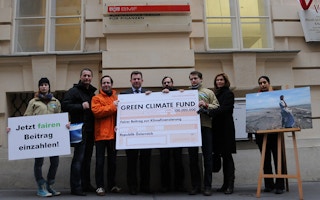The Green Climate Fund aims to have a new executive director at the helm by early next year, and has appointed an interim head to take over when the fund’s first director, Héla Cheikhrouhou, finishes her term in September, the chairs of its board said.
At a meeting in Korea this week, the board of the $10-billion fund - set up under U.N. climate talks to help developing countries tackle climate change - decided that Javier Manzanares, now the fund’s chief financial officer, would run its secretariat during the search for a new director.
The board hopes to make a decision from a shortlist of candidates at its next meeting in mid-October, enabling Cheikhrouhou’s replacement to take the reins from the end of 2016 or early 2017, said board co-chair Ewen McDonald.
At the meeting, which ended on Thursday, the fund’s board also approved its second set of projects to reduce climate-changing emissions and adjust to a warming world. The fund will invest a total of nearly $257 million in the nine projects.
Last November, before the Paris climate summit, it gave the green light to its first eight projects, worth $168 million.
The relatively low sums of money due to be doled out so far have raised doubts about whether the fund can meet an “aspirational goal” to allocate $2.5 billion this year - around a quarter of its available funds.
“
The GCF is not just about financing projects, it is about inspiring others to want to act.
Zaheer Fakir, co-chair, Green Climate Fund
But the board’s co-chairs remain optimistic.
“We’re not walking away from that aspiration in any way,” McDonald said from the Songdo district of Incheon, where the fund is based. “I am very confident that you will see some much bigger, different proposals approved in the last two board meetings of the year.”
The newly approved projects include insurance to guarantee energy savings for small businesses investing in energy efficiency in El Salvador, measures to enable eco-systems to adapt to climate shifts in Gambia, efforts to make coastal communities more resilient in Vietnam, and help for small-scale farmers in Sri Lanka to protect themselves from extreme weather.
There was criticism of some other projects by board members and civil society watchers, who argued a plan to develop solar energy in Chile and another to support World Bank climate action in Tajikistan and Uzbekistan were too much “business as usual”.
‘Dare to dream’
The Green Climate Fund (GCF) has a specific objective to promote a “paradigm shift towards low-emission and climate-resilient development pathways”, and aims to use its money to achieve “transformational impact”.
A set of interim risk and investment guidelines adopted this week said the fund “should be able to take on risks that other funds/institutions are not able or… willing to take”, and so wants to set “a high level of risk appetite”.
The board’s chairs said they were expecting to see more ambitious projects submitted in the future that would fit its mandate more clearly than those approved up to now.
Still, co-chair Zaheer Fakir said he did not think the latest projects could be described as “plain vanilla” because some will be implemented in small, low-income countries.
“The message (to governments) is… dare to dream - you can also be in that group,” he said. “The GCF is not just about financing projects, it is about inspiring others to want to act.”
McDonald, who is from Australia, said he had been reaching out to small island states in the Pacific, where countries could team up on clean energy or water conservation programmes, making them more attractive to private investors.
Liane Schalatek, who attended the meeting for the Heinrich Böll Foundation North America, said all the fund’s projects already have at least one transformational element, whatever their size or purpose, because they must include a plan to take gender into account.
“Not all countries can do super-new and innovative stuff,” she said. “There are proven technologies and proven approaches out there, and those still need to be funded.”
But if, at the same time, the GCF could help build up national institutions, that would be “very transformational”, she added. “That is what you need to sustain the benefits of the projects once the fund pulls out or the money ends,” she said.
Some civil society groups have pointed out that many of the projects approved so far are led by multilateral development banks and U.N. agencies rather than developing-country organisations, some of which need more time to be able to meet the fund’s criteria.
“The implementation of high-quality, environmentally sound projects that truly improve the lives of people in developing countries, especially the poor and the vulnerable, must not be sacrificed at the altar of expediency,” said Karen Orenstein, a climate finance expert with Friends of the Earth US.
Fakir, of South Africa, said three agencies there that want to receive money from the fund are working on large programmes they plan to submit but are keen to “do it correctly”, showing they can compete with international institutions.
The board postponed a decision on whether to accredit five new partners this week, amid controversy over an application by the Korean Export-Import Bank, with some arguing export credit agencies have too much of a domestic focus to work with the GCF.
This story was published with permission from Thomson Reuters Foundation, the charitable arm of Thomson Reuters, that covers humanitarian news, women’s rights, trafficking, corruption and climate change. Visit http://news.trust.org










